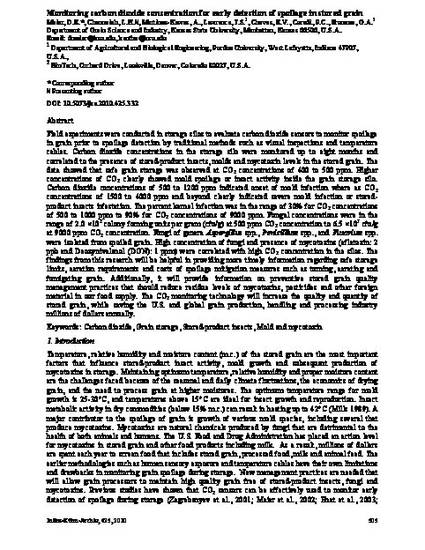
Presentation
Monitoring carbon dioxide concentration for early detection of spoilage in stored grain
10th International Working Conference on Stored Product Protection
(2010)
Abstract
Field experiments were conducted in storage silos to evaluate carbon dioxide sensors to monitor spoilage in grain prior to spoilage detection by traditional methods such as visual inspections and temperature cables. Carbon dioxide concentrations in the storage silo were monitored up to eight months and correlated to the presence of stored-product insects, molds and mycotoxin levels in the stored grain. The data showed that safe grain storage was observed at CO2 concentrations of 400 to 500 ppm. Higher concentrations of CO2 clearly showed mold spoilage or insect activity inside the grain storage silo. Carbon dioxide concentrations of 500 to 1200 ppm indicated onset of mold infection where as CO2 concentrations of 1500 to 4000 ppm and beyond clearly indicated severe mold infection or storedproduct insects infestation. The percent kernel infection was in the range of 30% for CO2 concentrations of 500 to 1000 ppm to 90% for CO2 concentrations of 9000 ppm. Fungal concentrations were in the range of 2.0 ×102 colony forming units per gram (cfu/g) at 500 ppm CO2 concentration to 6.5 ×107 cfu/g at 9000 ppm CO2 concentration. Fungi of genera Aspergillus spp., Penicillium spp., and Fusarium spp. were isolated from spoiled grain. High concentration of fungi and presence of mycotoxins (aflatoxin: 2 ppb and Deoxynivalenol (DON): 1 ppm) were correlated with high CO2 concentration in the silos. The findings from this research will be helpful in providing more timely information regarding safe storage limits, aeration requirements and costs of spoilage mitigation measures such as turning, aerating and fumigating grain. Additionally, it will provide information on preventive stored grain quality management practices that should reduce residue levels of mycotoxins, pesticides and other foreign material in our food supply. The CO2 monitoring technology will increase the quality and quantity of stored grain, while saving the U.S. and global grain production, handling and processing industry millions of dollars annually.
Keywords
- Carbon dioxide,
- Grain storage,
- Stored-product insects,
- Mold and mycotoxin
Disciplines
Publication Date
2010
Location
Estoril, Portugal
DOI
10.5073/jka.2010.425.332
Citation Information
D. E. Maier, L. H. Channaiah, A. Martinez-Kawas, J. S. Lawrence, et al.. "Monitoring carbon dioxide concentration for early detection of spoilage in stored grain" 10th International Working Conference on Stored Product Protection (2010) Available at: http://works.bepress.com/dirk-maier/46/
Creative Commons License

This work is licensed under a Creative Commons CC_BY-SA International License.
